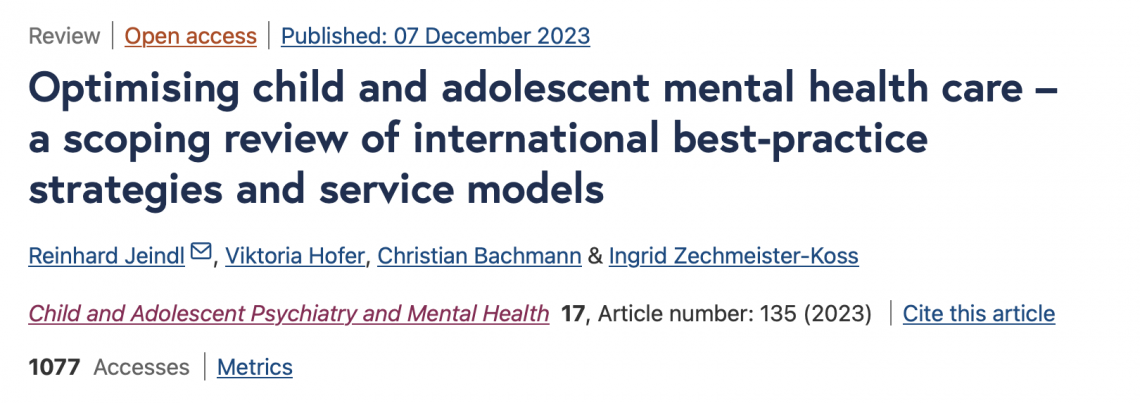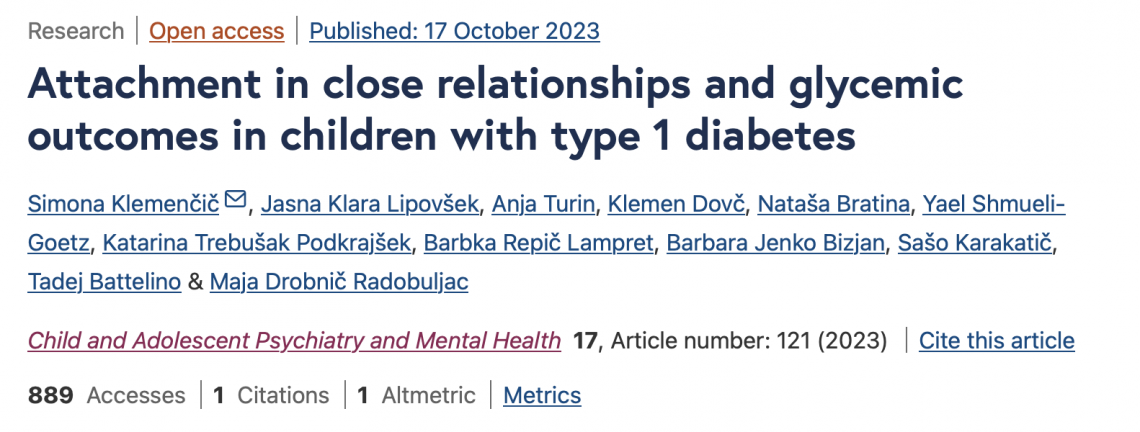CAPMH Corner (Updated Mar 2024)
By: Lakshmi Sravanti, India, Deputy Editor, CAPMH
Child and Adolescent Psychiatry and Mental Health (CAPMH) is the official IACAPAP Journal. The "CAPMH Corner" of the Mar 2024 issue of IACAPAP Bulletin summarizes the following three studies recently published in CAPMH – Optimising child and adolescent mental health care – a scoping review of international best-practice strategies and service models (Jeindl et al., 2023), Attachment in close relationships and glycemic outcomes in children with type 1 diabetes (Klemenčič et al., 2023) and Association of tumor location with anxiety and depression in childhood brain cancer survivors: a systematic review and meta‑analysis (Szabados et al., 2023).
Jeindl et al., (2023) underscore the increasing need for mental health care in children, especially post-COVID pandemic and limitations of the current models of care provision and delivery. They conduct a study to provide an overview of international child and adolescent mental health (CAMH) care strategies and models.
The team sets out to do a scoping review. They consider the applicability of the findings to the Austrian context. So, to ensure relevance, they limit their analysis to countries within the Global North, specifically focusing on those with the highest Human Development Index (HDI) according to the 2020 report. They include Australia, Switzerland, Czechia, Spain, Norway, the United Kingdom and Germany (due to its proximity to Austria and high comparability of the health systems) for the literature review. They carry out a structured hand search for national strategies and models addressing CAMH care and prevention between April and June 2022. They decide iteratively which information to extract and prepare data extraction tables for each of the selected documents. They identify 14 topic areas for data extraction – information activities, prevention/promotion, detection, treatment, telemedi¬cine, care pathways, transitional psychiatry, vulnerable patient groups, user participation, infrastructure, work¬force development, implementation, digital tools for case management, and data acquisition/research. They use an adapted version of the Appraisal of Guidelines for Research & Evaluation II (AGREE II) instrument.
The authors note that the overall quality of the documents ranged from 62 to 95%. They also mention that numerous particularly vulnerable groups, with a higher susceptibility to mental illness and frequently necessitating intricate care arrangements, have been identified throughout all the documents and that all countries recommend information and awareness-raising activities to increase health literacy and reduce stigma. In terms of treatment, they point out that there is an emphasis on the importance of expanding the variety of settings available, including options such as home-based care, treatment equivalent to inpatient care, various outreach approaches, and traditional inpatient treatment. Overall, they identify the following key principles – emphasis on prevention, early detection/intervention (including initiatives to enhance mental health awareness), better coordination, ensuring that CAMH (Child and Adolescent Mental Health) services are evidence-based, which includes the necessity for further research into mental health services, reinforcing participation, considering special treatment requirements, and establishing culturally sensitive and needs-based low-threshold services.
The team acknowledges the following limitations – use of a targeted hand search (instead of a systematic literature search); selection of countries based on the HDI as an indicator; excluding Asian countries; literature search being limited to June 2022, not collecting data on the extent to which the strategies have already been implemented; excluding documents addressing specific indications (e.g., medical guidelines), general health (instead of specific to mental health), or all ages (instead of specific to children and young people) and that the information extracted on the identified topic areas could not always be assigned to the identified categories. They conclude by strongly advocating for cross-sectoral and participatory approaches in CAMH care structures. They suggest that the health, education, social, and youth justice sectors should integrate mental health promotion, prevention, and care and that research should accompany strategic developments to address care shortcomings, especially for vulnerable patient groups.
Klemenčič et al., (2023) discuss the basics of attachment theory and the impact of stress response on diabetes (T1D) management in individuals with Type 1 Diabetes to establish a context for their current study. They conduct the study to understand the relationship between child attachment to parents, parental attachment styles, child stress reactivity, and glycemic outcomes in children and adolescents with T1D.
The team identifies all children (8–15 years) with T1D (for at least one year) and their parents from the Slovenian National Diabetes Registry and invites them to participate in the study. They recruit child-parent pairs who responded in the single-arm study at the University Medical Centre Ljubljana from July 2015 to December 2019 to follow them up prospectively for 4 years. They collect data on child and parent attachment (Child Attachment Interview; CAI and Relationship Structures Questionnaire; ECR-RS) and children’s morning serum cortisol at baseline and data on diabetes progression (glycated hemoglobin (HbA1c), HbA1c variability over 4 years and time in range (TIR) at regular 3-month outpatient visits. They use Pearson or the Spearman correlation coefficient to assess the relationship between two variables and linear regression with two-tailed hypothesis testing and significance level α = 0.05 for further analysis of the data.
The authors invite 124 parent–child pairs to participate, of whom 101 respond (response rate: 81.5%). They report that girls had higher average HbA1c than boys (B = −0.52, t = −2.02, p = 0.047); a higher percentage of secure attachment in girls compared to boys; a moderate correlation between parent attachment anxiety and parent attachment avoidance (r (91) = 0.43, p < 0.001); higher parental attachment avoidance was associated with higher average HbA1c in boys; in those whose parents reported low attachment avoidance (−1 SD) – girls had higher HbA1c variability than boys (B = −0.031, t = −3.153, p = 0.002), and higher morning cortisol levels were associated with higher HbA1c variability (B = 7e-5, t = 2.144, p = 0.035); and for children whose parents reported high attachment anxiety (+ 1 SD), girls had higher TIR than boys (B = −13.251, t = -2.451, p = 0.018).
The authors mention the strengths of their study – almost the entire cohort of children with T1D from Slovenia participate in the study, the use of well-established and validated interview measure, regular tracking of Hb1c levels for approximately 4 years and acknowledge its limitations – use of a self-report questionnaire to assess parental attachment could lead to over- or under-reporting; did not assess child or parental psychopathology; they could not obtain TIR data from all participants, and measurement of cortisol levels only once. They conclude by recommending clinicians to pay attention to girls who are independent and compliant (indicating secure attachment) but not yet able to control their diabetes and evaluate attachment needs in the regular assessment and management of girls and boys with T1D. They also suggest that using evidence-based attachment-oriented interventions in this population would be useful.
Szabados et al., (2023) highlight the importance of early detection and treatment of emotional disorders in children who survive cancer to reduce the severity and duration of symptoms, avoid relapse, and improve overall functioning. They conduct a meta-analysis to determine the relationship between the location of the brain tumor and the prevalence of anxiety disorder and major depression, to provide professionals with better options for diagnosis and interventions designed to treat psychological disorders at an early stage.
The authors register their protocol on PROSPERO (CRD42022370756), follow the Cochrane Handbook for methodological guidance and use the Preferred Reporting Items for Systematic Reviews and Meta-Analyses (PRISMA) statement to report their findings. They perform search in five scientific databases: Medline (via PubMed), Embase, Cochrane Central Register of Controlled Trials (CENTRAL), Scopus, and Web of Science. The search key includes the following domains: pediatrics, brain cancer, location, and affective disorders. A pair of review authors independently screen articles by title, abstract, and full text based on predefined eligibility criteria and extract data from eligible studies using a standardized data collection form. They use the Quality in Prognostic Studies 2 (QUIPS-2) tool to assess risk of bias and Cohen’s kappa to assess interrater agreements during selection. A third author resolves conflicts in selection. With regard to statistical analyses – the team uses random intercept logistic regression models to estimate prevalence, performs a subgroup analysis based on tumor location and test heterogeneity using Cochrane’s Q [N + 3] and Higgins & Thompson’s I squared statistics.
They identify 6692 records and 1564 records through the references and include 42 studies in the quantitative analysis. The overall prevalence of major depression and anxiety among survivors of brain tumors was 22% each. They analysed 17 studies that showed no difference in the prevalence of major depression between infratentorial (INF) and supratentorial (SUP) brain tumor survivors [proportions: INF 0.21 (CI 0.10–0.41); SUP 0.23 (CI 0.12–0.38]. They carried out a pooled analysis of 11 studies, which showed no statistically significant difference in the prevalence of anxiety between infratentorial (INF) and supratentorial (SUP) brain tumor survivors [proportions: INF 0.26 (CI 0.05–0.69); SUP 0.18 (CI 0.06–0.41]. Infratentorial (INF) brain tumor survivors tended to score higher on depression and anxiety inventories than supratentorial (SUP) brain tumor survivors. They report a low risk of bias in 36% of the papers, moderate in 24%, and high in 40%. The notable bias risk primarily stemmed from insufficient information regarding confounding factors and a lack of details on methodology and statistical analyses.
The team mentions the strengths –the first comprehensive meta-analysis on this topic in the pediatric population, rigorous methodology, assessed and justified the heterogeneity detected in the analyses, and limitations of their study – results were obtained from retrospective cohort and cross-sectional studies also, some studies included in the analysis had a rather low number of patients, comparisons were only made by subgroup analysis, rather than direct comparisons within subgroups, did not perform subgroup analyses by treatment modalities because of the lack of information and heterogeneity of tumor types, did not perform meta-regression due to lack of data, and did not investigate the prevalence of different types of anxiety diagnoses. They conclude by highlighting that one in five patients surviving pediatric brain tumor develops major depression and anxiety disorder and those treated for infratentorial tumors face elevated risks and exhibit poorer depression and anxiety scores. They recommend conducting prospective cohort studies with standardized follow-up times and use of standardized measurement tools for precise analysis.
REFERENCES:
- Jeindl, R., Hofer, V., Bachmann, C. et al. Optimising child and adolescent mental health care – a scoping review of international best-practice strategies and service models.Child Adolesc Psychiatry Ment Health 17, 135 (2023). https://doi.org/10.1186/s13034-023-00683-y
- Klemenčič, S., Lipovšek, J.K., Turin, A. et al. Attachment in close relationships and glycemic outcomes in children with type 1 diabetes. Child Adolesc Psychiatry Ment Health 17, 121 (2023). https://doi.org/10.1186/s13034-023-00672-1
- Szabados, M., Kolumbán, E., Agócs, G. et al. Association of tumor location with anxiety and depression in childhood brain cancer survivors: a systematic review and meta-analysis. Child Adolesc Psychiatry Ment Health 17, 124 (2023). https://doi.org/10.1186/s13034-023-00665-0




